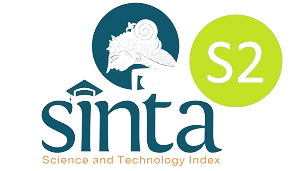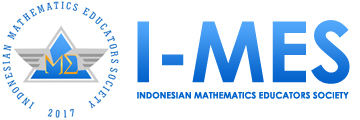Profil Kemampuan Penalaran Kreatif Matematis Mahasiswa Calon Guru
DOI:
https://doi.org/10.29408/jel.v6i1.1738Keywords:
grounded theory, mathematical creative reasoning, prospective teacherAbstract
This study aims to obtain an overview of the mathematical creative reasoning abilities of the prospective teacher. The ability of mathematical creative reasoning in this study is the ability of students to justify a statement on the grounds of the truth of a statement that is based on novelty, plausible, and mathematical foundation. This research approach is qualitative using Grounded Theory. The population in this study were all students participating in the Calculus class of the Study Program Mathematics Education at one of the universities in West Java. In a while, the sample of 55 students was selected by a cluster random sampling technique. The results showed that students' mathematical creative reasoning abilities were categorized into three levels of ability based on the quality of the four categories, namely the initial step, the flow of completion, the related concepts, and the mathematical term errors.References
Arends, R. I. (2006). Performance assessment in perspective: history, opportunities, and challenges. Assessing Teacher Performance: Performance-Based Assessment in Teacher Education, 3–22.
Bergqvist, E. (2007). Types of reasoning required in university exams in mathematics. Journal of Mathematical Behavior, 26(4), 348–370. https://doi.org/10.1016/j.jmathb.2007.11.001.
Bergqvist, T., & Lithner, J. (2012). Mathematical reasoning in teachers’ presentations. Journal of Mathematical Behavior, 31(2), 252–269. https://doi.org/10.1016/j.jmathb.2011.12.002.
Bhaird, C. M., Nolan, B. C., O’Shea, A., & Pfeiffer, K. (2017). A study of creative reasoning opportunities in assessments in undergraduate calculus courses. Research in Mathematics Education, 19(2), 147–162. https://doi.org/10.1080/14794802.2017.1318084.
Bowen, G. A. (2006). Grounded theory and sensitizing concepts. International Journal of Qualitative Methods, 5(3), 12–23. https://doi.org/10.1177/160940690600500304.
Castle, S., Arends, R. I., & Rockwood, K. D. (2008). Student learning in a professional develoment school and a control school. Professional Educator, 32(1), 1–15.
Cresswell, J. W. (2010). Research design pendekatan kuantitatif, kualitatif dan mixed edisi ketiga. Yogyakarta: Pustaka Pelajar.
Hanifah, A. I. (2016). Analisis kesalahan siswa dilihat dari skema dalam menyelesaikan masalah matematika. Jurnal Reforma, 4(1), 30-41. https://doi.org/10.30736/rfma.v4i1.9.
Hendriana, H., Prahmana, R. C. I., & Hidayat, W. (2018). Students’ performance skills in creative mathematical reasoning. Infinity Journal, 7(2), 83-96. https://doi.org/10.22460/infinity.v7i2.p83-96.
Hershkowitz, R., Tabach, M., & Dreyfus, T. (2017). Creative reasoning and shifts of knowledge in the mathematics classroom. ZDM - Mathematics Education, 49(1), 25–36. https://doi.org/10.1007/s11858-016-0816-6.
Hidayah, S. (2016). Analisis kesalahan siswa dalam menyelesaikan soal cerita SPLDV berdasarkan langkah penyelesaian Polya. Jurnal Pendidikan, 1(2), 182-190. https://doi.org/10.26594/jmpm.v1i2.582.
Hidayat, W. (2017). Adversity quotient dan penalaran kreatif matematis siswa SMA dalam pembelajaran Argument Driven Inquiry pada materi turunan fungsi. KALAMATIKA Jurnal Pendidikan Matematika, 2(1), 15–28. https://doi.org/10.22236/KALAMATIKA.vol2no1.2017pp15-28.
Hidayat, W., Herdiman, I., Aripin, U., Yuliani, A., & Maya, R. (2018). Adversity Quotient (AQ) dan penalaran kreatif matematis mahasiswa calon guru. Jurnal Elemen, 4(2), 230-242. https://doi.org/10.29408/jel.v4i2.701.
Irawati, S. (2015). Analisis kesalahan mahasiswa calon guru matematika dalam memecahkan masalah program linier. Sigma, 1(1), 29-34.
Jones, M., & Alony, I. (2011). Guiding the use of grounded theory in doctoral studies - an example from the australian film industry. International Journal of Doctoral Studies, 6, 95–114. https://doi.org/10.28945/1429.
Jonsson, B., Kulaksiz, Y. C., & Lithner, J. (2016). Creative and algorithmic mathematical reasoning: effects of transfer-appropriate processing and effortful struggle. International Journal of Mathematical Education in Science and Technology, 47(8), 1206–1225. https://doi.org/10.1080/0020739X.2016.1192232.
Jonsson, B., Norqvist, M., Liljekvist, Y., & Lithner, J. (2014). Learning mathematics through algorithmic and creative reasoning. Journal of Mathematical Behavior, 36, 20–32. https://doi.org/10.1016/j.jmathb.2014.08.003.
Kasmer, L., & Kim, O. K. (2011). Using prediction to promote mathematical understanding and reasoning. School Science and Mathematics, 111(1), 20–33. https://doi.org/10.1111/j.1949-8594.2010.00056.x.
Lithner, J. (2008). A research framework for creative and imitative reasoning. Educational Studies in Mathematics, 67(3), 255–276. https://doi.org/10.1007/s10649-007-9104-2.
Lithner, J. (2014). Mathematical reasoning in task solving. Educational Studies in Mathematics, 41(2). https://doi.org/10.1007/s13398-014-0173-7.2.
Lithner, J. (2017). Principles for designing mathematical tasks that enhance imitative and creative reasoning. ZDM, 49, 937–949. https://doi.org/10.1007/s11858-017-0867-3.
Munandar, U. (2009). Pengembangan kreativitas anak berbakat. Jakarta: Rineka Cipta.
Siswono, T. Y. E. (2004). Identifikasi proses berpikir kreatif siswa dalam pengajuan masalah (problem posing) matematika berpandu dengan model Wallas dan Creative Problem Solving (CPS). Buletin Pendidikan Matematika, 6(2), 1–16.
Siswono, T. Y. E., & Novitasari, W. (2007). Meningkatkan kemampuan berpikir kreatif siswa melalui pemecahan masalah tipe What’s Another Way. Jurnal Trasformasi, 1(1), 1-13.
Sutini, S. (2019). Kemampuan metakognitif dan komunikasi matematis dalam pemecahan masalah matematika. Jurnal Review Pembelajaran Matematika, 4(1), 32-47.
Widodo, S. A. (2013). Analisis kesalahan dalam pemecahan masalah divergensi tipe membuktikan pada mahasiswa matematika. Jurnal pendidikan dan pengajaran, 46(2), 106-113.
Widyastuti, R. (2015). Proses berpikir siswa dalam menyelesaikan masalah matematika berdasarkan teori Polya ditinjau dari adversity quotient tipe climber. Al-Jabar: Jurnal Pendidikan Matematika, 6(2), 183-194.
Downloads
Published
How to Cite
Issue
Section
License
Authors who publish with the Jurnal Elemen agree to the following terms:
- Authors retain copyright and grant the journal right of first publication with the work simultaneously licensed under Creative Commons Attribution-ShareAlike 4.0 International License (CC BY-SA 4.0).
- Authors are able to enter into separate, additional contractual arrangements for the distribution of the journal's published version of the work (e.g., post it to an institutional repository or publish it in a book), with an acknowledgment of its initial publication in this journal.
- Authors are permitted and encouraged to post their work online (e.g., in institutional repositories or on their website) prior to and during the submission process, as it can lead to productive exchanges, as well as earlier and greater citation of published work.
Jurnal Elemen is licensed under a Creative Commons Attribution-ShareAlike 4.0 International License





